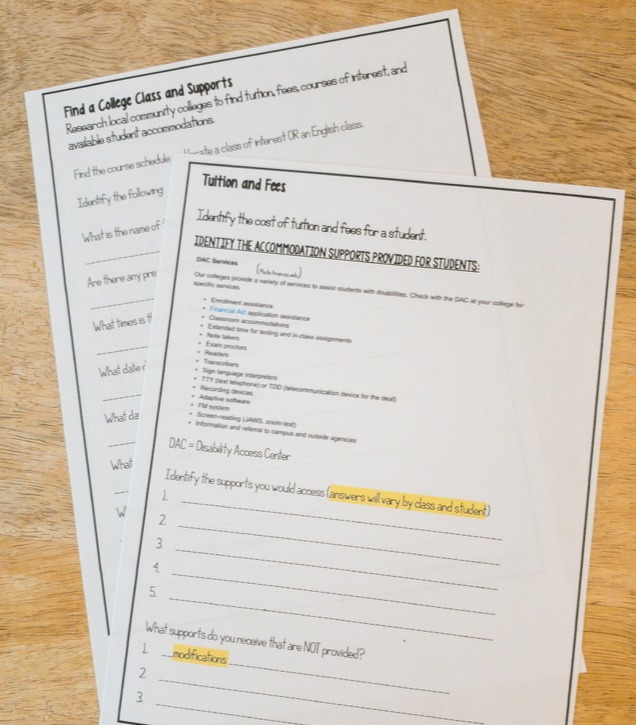How to Teach College Tuition and Class
Apr 17, 2021
Our LAST topic in the Consumer Math Blog Series is about how to teach College Tuition and Classes. Read more about why and how you can teach College Tuition and Classes using my College Class and Tuition Lesson Unit (click here to get your copy).
Purpose of Teaching about College Tuition and Classes
If you have students in your class who have expressed they wanted to go to college during the Goal Setting lesson or it’s near the end of the year and your students are feeling pressured to say they are going to college, then this lesson will help you lay the foundation for student understanding of college tuition and classes. This lesson is intended to give your students a QUICK crash course into what it’s like to pay tuition and sign up for a college course.
College Class and Tuition Lesson Unit
Key-Must-Teach Concepts
Learning costs money. Unlike traditional public education, college is optional and can cost far more money than students realize. Tuition, books, extra fees, parking, etc all adds up. Helping students see that these costs are associated with taking a college class will help begin to prepare them mentally for signing up for a course.
Second chances cost money. College is ‘modification free’ and students, regardless of their ability level, have to perform to earn a passing grade. If a student fails a class (which can be a successful failure, but that is a conversation for another day), then they have to pay again to take the class over.
Lesson Objective
Identify the steps and financial obligation of taking a college-level class.
Lesson Unit Break Down
Day 1- I feel like a broken machine, but it’s true. This introduction just works! Throw out the brain teaser, cover the reading passage (see Reading Passage Option below), do a quick check for understanding with the T/F questions, and then exercise the brain with the writing prompts.
Day 2- Move from general to specific with the Notes and Parts worksheet. The Parts worksheet begins to hammer out the main ideas and vocabulary for this lesson unit. The college fee section can be really eye opening for students!
Day 3- Jump right in with guided practice. First up is the Tuition and Fees walkthrough. In small groups or pairs, students will begin to see the financial commitment of a full and/or part time student. Now is also a good time to talk about disclosing your disability, since this is optional!
Next is the Reading a Course catalog. I’d be lying if I said this was easy for our students. It’s like a special code and the more you expose them to it the better they will understand it.
Day 4-Independent practice has students using real life information from a local college to determine the cost of a single class, finding the office of accommodations, and locating and reading a course catalog.
Day 5- End this lesson unit with your trusty task cards (see Task Card Idea below)! Assess your students’ understanding, offer a functional math review (because you can never review these concepts too much), and relax with a word search!
College Class and Tuition Lesson Unit
Reading Passage Option
Using Chrome, download a Text to Speech extension and have it read the article to the class! I’ve had success with Read Aloud, but new ones are coming out, so just search the Google Web Store for options (just be sure to test it before class and set your voice and reading speed). Since just a random voice won’t be enough, re-read the passage or do a traditional popcorn read to revisit the topics in the reading passage.
Listen and Learn
A Listen & Learn is a short, 5 sentence PowerPoint/Google presentation that introduces the topic using visuals and audio. Ideal for non-readers! Read about what they are and how they might be right for your classroom here.
Task Card Idea
The fly swatter game is loosely similar to the around the world (yes, the game you played in grade school with multiplication facts). Have 2 students stand a few feet from the projector and give each of them a flyswatter. Using the projector, zoom in on one task card (use your projector’s remote audio/visual mute button, if it has one) and have the students read the question and swat the right answer. The winner gets to move on. This can cause a lot of excitement and can get students really involved in the review!
College Class and Tuition Lesson Unit
Further Practice Idea
Ask a guidance counselor to come to speak to your class about the process of taking a college class. Ask them to use simple terms, simple examples, and to be frank about the demands of college, academically and financially speaking. Hopefully, they will be the most well versed to speak to your local options and the options that are most appropriate for your students.
Ultimate Goal of the Lesson Unit
Registering for a college class is a multi-step and time consuming process. Helping students to see that this is both a time and financial commitment is the ultimate goal of this lesson. Making them aware of the process by being transparent in the steps will help prepare the most interested students for the reality of becoming a college student.
College Class and Tuition Lesson Unit
May I Also Suggest Teaching
If your students plan to drive themselves to college or want to drive, then combine this lesson unit with the Buying a Car lesson. If not, then pair this with the Savings Account lesson and help them to see that saving money can help them to pay for college responsibly.

















